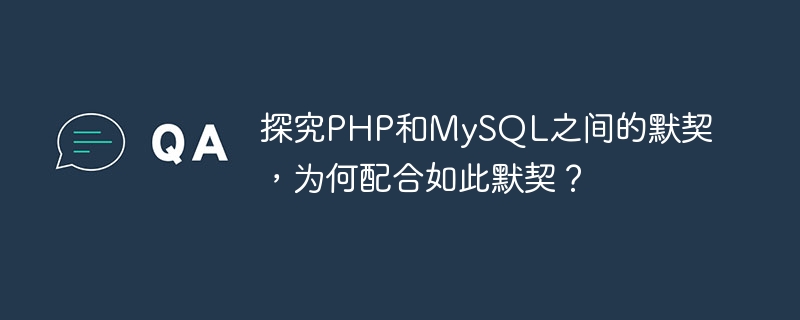Home >Database >Mysql Tutorial >Explore the tacit understanding between PHP and MySQL. Why do they work so well together?
Explore the tacit understanding between PHP and MySQL. Why do they work so well together?
- PHPzOriginal
- 2024-03-01 21:57:03755browse

PHP and MySQL are golden partners in web development. Their tacit cooperation allows developers to quickly create powerful dynamic websites and web applications. In this article, we will delve into the tacit understanding between PHP and MySQL and analyze why they work so well together. At the same time, we will illustrate the collaborative relationship between them with specific code examples.
PHP is a popular server-side scripting language widely used for web development. MySQL is an open source relational database management system used to store and manage data. The cooperation between PHP and MySQL can be said to be a perfect match, mainly reflected in the following aspects:
- Database connection
In web development, PHP is usually used to process dynamic content and interact with databases Interaction. The tacit understanding between PHP and MySQL is reflected in the ease of establishing a database connection between them. Developers can use extensions such as mysqli or PDO in PHP to connect to the MySQL database and perform query operations.
The following is a simple PHP code example that demonstrates how to connect to a MySQL database:
<?php
$servername = "localhost";
$username = "root";
$password = "";
$dbname = "mydatabase";
// 创建数据库连接
$conn = new mysqli($servername, $username, $password, $dbname);
// 检查连接是否成功
if ($conn->connect_error) {
die("连接失败: " . $conn->connect_error);
} else {
echo "连接成功";
}
?>- Database Query
The tacit understanding between PHP and MySQL is that they can Seamlessly perform database query operations. Developers can use SQL statements in PHP to query data in the database and return the results to the web page. This cooperation makes the development of dynamic web pages more efficient and flexible.
The following is a simple PHP code example that demonstrates how to execute a SELECT query and output the results:
<?php
$sql = "SELECT id, name, email FROM users";
$result = $conn->query($sql);
if ($result->num_rows > 0) {
while($row = $result->fetch_assoc()) {
echo "ID: " . $row["id"]. " - Name: " . $row["name"]. " - Email: " . $row["email"]. "<br>";
}
} else {
echo "0 结果";
}
$conn->close();
?>- Database update and delete
In addition to query operations, PHP The tacit understanding with MySQL is also reflected in updating and deleting data records. Developers can use PHP code to insert new data, update data records, or delete data records into the database, thereby adding, deleting, and modifying data.
The following is a simple PHP code example that demonstrates how to perform UPDATE and DELETE operations:
<?php
// 更新数据
$sql = "UPDATE users SET email='newemail@example.com' WHERE id=1";
if ($conn->query($sql) === TRUE) {
echo "数据更新成功";
} else {
echo "更新出错: " . $conn->error;
}
// 删除数据
$sql = "DELETE FROM users WHERE id=2";
if ($conn->query($sql) === TRUE) {
echo "数据删除成功";
} else {
echo "删除出错: " . $conn->error;
}
$conn->close();
?>To sum up, the tacit cooperation between PHP and MySQL is reflected in their complementarity and efficiency. PHP, as a server-side scripting language, can handle dynamic content, while MySQL, as a database management system, is responsible for storing and managing data. The tacit cooperation between them allows developers to quickly build powerful web applications. This tacit relationship brings convenience and efficiency to web development, and has become the preferred technology combination for many developers.
The above is the detailed content of Explore the tacit understanding between PHP and MySQL. Why do they work so well together?. For more information, please follow other related articles on the PHP Chinese website!

